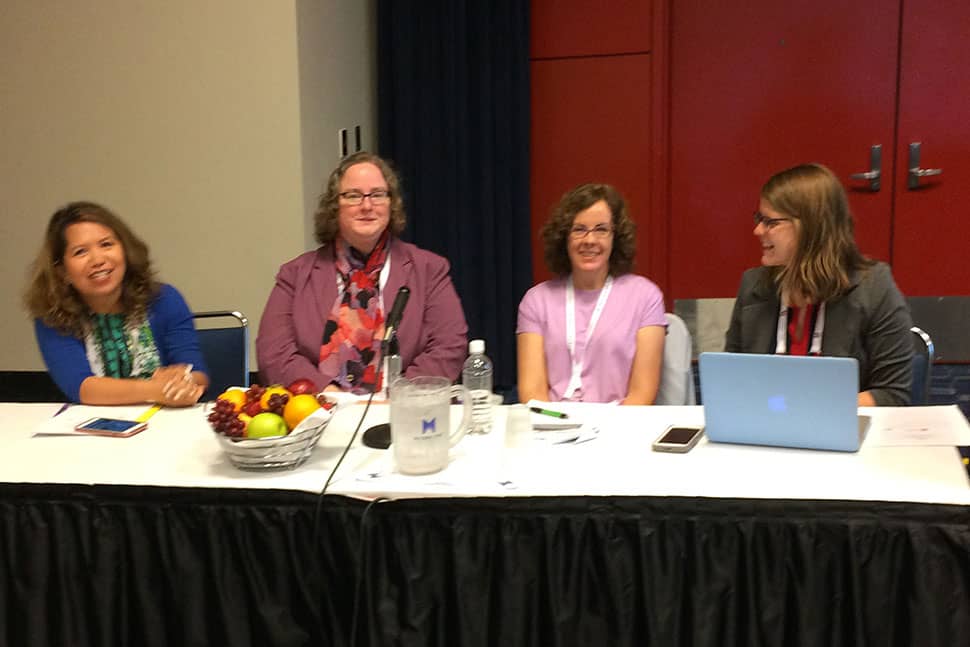
The Science and Technology Section (STS) of the Association of College and Research Libraries (ACRL) hosted a panel discussion titled “OER: Science Liaisons Strengthening the Academy with Open Resources.” Moderator Sarah Crissinger, scholarly communication librarian at Indiana University, introduced the session with some basic information on OER.
OER is a learning object, shared under an intellectual property license, that facilitates the 5 Rs: retain, reuse, revise, remix, and redistribute. David Wiley of Lumen Learning created the 5 Rs, and they serve as the foundation of any OER initiative. Crissinger also introduced the concept of Open Pedagogy, which asks students to be involved in the creation and revision of OER, pushing back against the narrow view of expertise established in academia.
Crissinger acknowledged the strengths and weaknesses of OER. The strengths are the plethora of OERs that are available to instructors and cover a broad array of disciplines. Current course materials are often accompanied by high costs, which OER combats by being freely available. Some of the weaknesses are that creation of OERs can present unique issues that instructors are not equipped to solve. Also, for science, technology, engineering, and mathematics, lab manuals, access codes, and answer keys that are already in use would need OER replacements.
Start where you are
The first speaker was Merinda McLure, associate professor and health and human services librarian at University of Colorado–Boulder, who began with three tips. First, librarians can start where they are. All librarians need to get started is the desire to see OER embraced by their institutions. Next, librarians need to enjoy embracing collaboration. Collaboration between the librarian and the faculty is the key to any successful OER initiative. But librarians should also include their deans, offices of research, provosts, and any other appropriate institutional stakeholders.
Last, librarians should look to the OER community, especially the successful examples. Librarians all over the country have experienced success with OER and published their results. Additionally, the OER community is open to help, so librarians can directly contact other librarians involved with OER.
McLure also armed the audience with a variety of resources related to OER. “2016 Student Textbook and Course Materials Survey,” conducted by Florida Virtual Campus, provides excellent insight into average costs for student course materials. “Opening the Textbook: Educational Resources in U.S. Higher Education, 2015-16” by Babson Survey Research Group provides a snapshot of OER’s footprint on campus and perceived barriers to adoption. And “SPEC Kit 351: Affordable Course Content and Open Educational Resources” by the Association of Research Libraries outlines the contributions of academic libraries to OER on campus.
The OER community includes SPARC Libraries and OER Forum, an open Google group dedicated to OER. OER Digest, a joint venture between SPARC and Student PIRGS, aggregates OER news into a bi-weekly email. Rebus and the Open Textbook Network provide office hours during which people can ask questions about OER. Meanwhile, the Open Education Group provides a review of all empirical research on the impacts of OER adoption.
OER and NSF
Nina Exner, researcher and grant support services librarian at North Carolina A&T State University in Greensboro, spoke specifically about OER and National Science Foundation (NSF) grants. NSF grants contain specific criteria for intellectual merit and broader impact. These criteria often take the form of journal articles but can also take the form of OER. Lectures and course materials, which can also be designated as OER, can be licensed under Creative Commons. Ultimately, these course materials and products can satisfy a portion of the intellectual merit and broader impacts criteria.
Regina Gong, librarian and OER project manager at Lansing (Mich.) Community College, discussed the realities of OER on a campus where 90% of the faculty are adjunct status. Gong started the initiative with the help of a few faculty champions. The selling points were to improve textbook affordability but also increase faculty flexibility by allowing them to be reinvigorated by the freedom of OER.
Gong’s success started by meeting with faculty, which she did by inviting herself to the meetings, asking to be on agendas, and always bringing sign-up sheets for followup. Gong also conducted a series of workshops, some with instructional designers at her campus and some with her faculty champions. Gong brought in outside experts to aid her cause, including David Wiley, the creator of the 5 Rs of OER. She stressed, too, the importance of partnerships, but not just partnerships within her institution. Gong reached out to OpenStax and other national OER cohorts to include her college as an institutional partner. These partnerships built a network of experts that have allowed her OER initiative to succeed.
For Gong, the final piece of the OER puzzle was the social justice portion. At a community college, all students are able to attend as long as they pay tuition. With tuition around $104 per credit hour, textbooks are often more expensive than tuition. Gong emphasized that equitable access to information and the democratization of education are a large impetus for OER adoption. Gong shared an anecdote about a faculty member who once had to walk a pair of students to the campus food pantry; immediately following this sobering experience, the faculty member knew they could no longer ask their students to pay for textbooks, if students were potentially choosing education over food.
Update: Corrected the spelling of Merinda McLure’s name, July 7, 2017.


